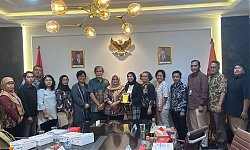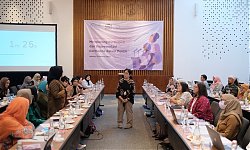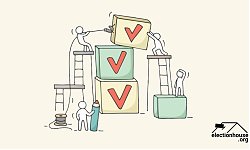Women in the Indian political process is progressing. The patriarchal system is undergoing changes," said George Mathew, Chair of the New Delhi Institute of Social Sciences, at the seminar "Women, Islam, and Politics: Indonesia and India" at the Widya Graha building of the Indonesian Institute of Sciences (LIPI), Kuningan, South Jakarta (8/22).
On this occasion, George explained the development of women's politics in India. He started by mentioning the names of women leaders in India. Names Rani of Jhansi, Queen of the Jhansi region, Sarojni Naidu, governor of Agra and Oudh Provinces, Kasturba Gandhi, wife of Mahatma Gandhi who was also a leader of independence fighters during the British era, Aruna Asaf Ali, Indian independence activist, and Indira Gandhi, former Prime Minister India is proof that women have the ability to be leaders.
Demographically, in 2019, India's total population reached 1.35 billion people. It consists of 697 million men and 653 million women. The number of women, which is almost equal to the number of men, is not represented in formal politics. In the 2019 Indian elections, of the 545 seats in the Lok Sabha, the lower house of India's parliament, only 78 seats were won by women. In other words, the percentage rate of women in the Lok Sabha is only 14.3 percent. This figure is indeed an increase from the number of women elected in the previous Lok Sabha Member Elections in 2014 and 2009, namely 61 and 59 women. However, not a number representation is needed.
“There are still very few women present in parliament. In total, there are only 617 women in parliament during the 1962 General Election,” said George.
George explains why it is difficult for women to be chosen. The first is the patriarchal system in which men dominate and control society. The second is the caste system. The high caste reigns over the lower caste. Third, a multi-religious society often causes horizontal conflicts. Fourth, is the low level of community literacy. 60 percent of Indians cannot read and write.
"For Hindus, there are still many who don't want to sit near Muslims. Or because they feel the majority, they feel more powerful than the minority. So, fighting with each other, there is no consolidation of the integrated women's movement across castes, across religions, across majority-minorities," he explained.
Women, according to George, have been building social capital through social organizations, such as regional-based organizations, professional-based organizations, and faith-based organizations. There are already quite a several women who are leaders in these organizations.
“Many women lead these organizations. India has a lot of good media. Women who work in the media highlight the success of women's leadership," explained George.
Tanya Jankimow, a senior lecturer at New South Wales University, has another opinion regarding the causes of the lack of selected women. She argues, India's electoral system does not favor the position of women. Although the law in the states of India has implemented a seat quota for women, in practice, the granting of quota tickets by political parties causes conflicts among women parties. Political parties do not give other affirmations to help women activists of elected parties.
"There is a quota system. 33 percent of all seats must be for women. A party may nominate one person from its party. In practice, there was a fight over party tickets. Moreover, there is no mechanism to determine what kind of party women are entitled to get tickets to enter the women's quota,” explained Tanya.
From the research conducted by Tanya in India, women activists and party cadres do not get enough appreciation from political parties. Women play an important role in mobilizing voters and driving party machines to campaign, but women rarely benefit from party policies related to elections. Disappointed, as a result, many women activists and party cadres decided to move forward from the independent path.
"Their energy is being used. But then they did not get a nomination ticket from their party. They also do not receive assistance or reinforcement to be elected. This is also happening in Indonesia," said Tanya.
Tanya recommended that states in India revise the rules for the women's quota system. There should be an official mechanism to determine party women who are entitled to nomination tickets from the party.
As of 2019, in 14 states, the representation rate of women in state parliaments was 50 to 58 percent. The state of Jharkhand holds the record for the highest female representation rate, at 58 percent. Followed by Rajasthan and Uttarakhand in second and third place. []
AMALIA SALABI
This article is translated by Catherine Natalia.











